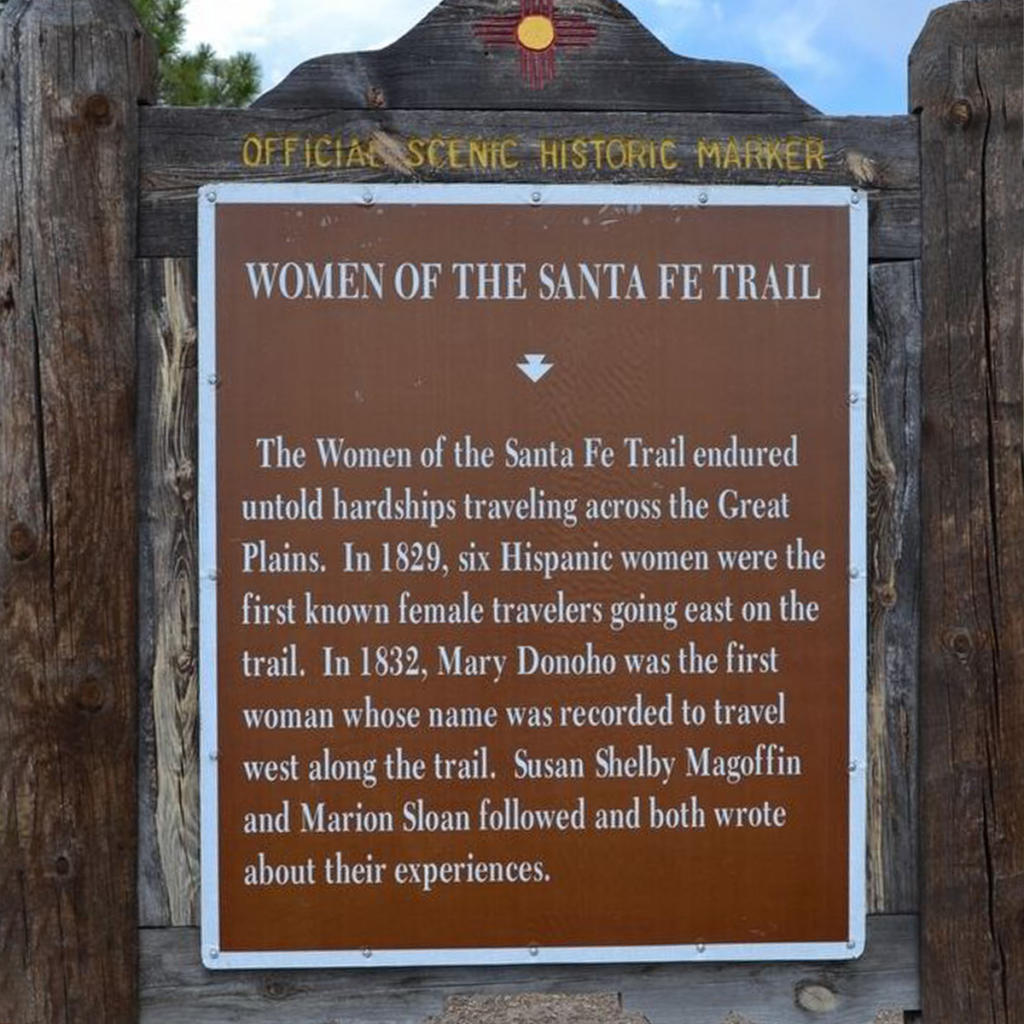Women of the Santa Fe Trail historic marker.
Photo Credit: Courtesy of New Mexico Historic Women Marker Program. Illustration by Joe Kimmel.
Women of the Santa Fe Trail
1821 - 1880s
Colfax County
While their names remain lost in history, the women who crossed the Great Plains on the Santa Fe Trail brought significant change to the territory that would become New Mexico. As they raised families and shaped communities, their tastes and values influenced everything from culture to architectural styles.
When women began crossing the plains of the United States on the Santa Fe Trail to the newly acquired U. S. Territory of New Mexico, they brought new sensibilities and priorities. Through activities as wide ranging as raising families, teaching music and literature, introducing new foods, and advocating for their respective religions, women’s tastes in clothing, furniture, gardens, and architectural styles influenced the developing culture of New Mexico and remain a part of the culture today.
Long before it was named, the Santa Fe Trail served as an east-west trading route from Missouri to present day Santa Fe. Records and evidence of Indian guides indicate that the trail was used before Europeans. Around 1542, Francisco Vásquez de Coronado used Indian guides to lead him down the route from what he called Quivera (Wichita, Kansas) to New Mexico near Bernalillo. In 1601, Juan de Oñate led an expedition that included wagons over the Great Plains by following the Canadian River. Again, guided by Indians, the expedition returned along the Santa Fe Trail route.
Between Oñate’s trip in 1601 and the commonly agreed upon opening of the Santa Fe Trail in 1821, countless people in countless expeditions had traveled the route. After 1821, trade expeditions and caravans became commonplace. While the number of women who participated in those trips is unknown, Native American women are widely believed to have been the first females to travel on the trail.
In 1829, six Hispanic women were the first known eastbound female travelers on the Santa Fe Trail. In the patriotic fervor of independence, the Mexican governments looked unfavorably on “peninsulares,” or people born or loyal to Spain. Exiled from New Mexico, the women along with ten men, were traveling to St. Louis, after all or a good part of the group of sixteen was apparently targeted and exiled. When the group joined a caravan, the six women became the first to be recorded as traveling on the trail, though their individual names have not been recovered in written records. All disappeared from the pages of history after their arrival in St. Louis in 1829.
Soon after, in 1833, Mary Donoho became the first documented woman to travel on the road to Santa Fe from the United States. She traveled with her husband and a nine-month-old daughter to Santa Fe where they opened a hotel. The next documented woman to travel the trail was nineteen-year-old Susan Shelby Magoffin, who traveled all the way into north central Mexico with her merchant husband and wrote about their experiences.
After the Mexican War in 1846-1848, women traveling the trail became more commonplace, especially from the United States. Marion Sloan, who wrote about her experiences, initially traveled with her mother Eliza to New Mexico in 1851 and subsequently traveled the Santa Fe Trail nine more times in the next ten years.
While their names and number may never be known, the women who made the difficult journey along the Santa Fe Trail changed New Mexico, bringing values and personal tastes that remain part of the culture today.
Sources:
Women of the Santa Fe Trail; History – The Santa Fe Trail; Travelers on the Trail
Marion Sloan Russell
Russel, Mary Sloan. Land of Enchantment: Memoirs of Marian Russell Along the Santa Fe Trail. Albuquerque: University Of New Mexico, 1954.
Wadsworth, Ginger, Marion Sloan Russell, and James Watling. Along the Santa Fe Trail: Marion Russell’s Story. Martin Grove, IL: Albert Whitman, 1993.
Directions:
Women of the Santa Fe Trail
Colfax County
Community leader |
Mexican Period (1821 - 1848) | Territorial Period (1848 - 1912) |
Northeast







